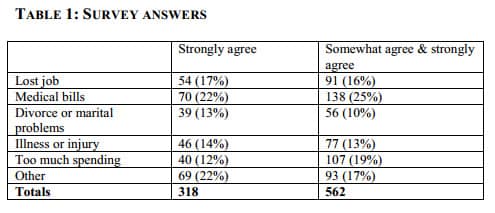

“[Health care] is a cost that now causes a bankruptcy in America every 30 seconds,” President Obama said in his 2009 State of the Union address.
When Northeastern University Professor of Law Daniel Austin heard that, he knew something didn’t feel right.
“My gut feeling for bankruptcy based on years of experience was that, up to this point, was simply not this big of a factor when driving people to bankruptcy,” said Austin, who has more than 23 years of experience practicing bankruptcy law. “I did some informal polling among bankruptcy trustees and other lawyers I know. They also felt that this number was off the charts.”
In his latest paper “Medical Debt as a Cause of Consumer Bankruptcy,” Austin aims to do two things: provide a new, more accurate definition of “medical bankruptcy” and provide a clear and reasonable estimate of its prevalence in the United States today.
Redefining “medical bankrtupcy”
Obama’s statement came from a 2009 study “Medical Bankruptcy in the United States, 2007: Results of a National Study” published in the American Journal of Medicine (which, curiously, said medical bankruptcies occur every 90 seconds as opposed to 30).
Co-authored by Harvard and Ohio University researchers David Himmelstein, Deborah Thorne, Steffie Woolhandler and Elizabeth Warren* (which we’ll refer to as “the Himmelstein study” for brevity), the study deemed a bankruptcy “medical” when debtors either:
- cited illness or medical bills as a specific reason for bankruptcy
- had medical bills exceeded $1,000 in the past two years
- lost two weeks or more of work-related income due to illness/injury
- mortgaged a home to pay medical bills
“The term ‘medical bankruptcy’ is not a technical term, despite the way we toss it around,” Austin said. “It’s not defined in the code. What is a medical bankruptcy? How do you define it? The Himmelstein study defined med bankruptcy very, very broadly.”
For example, Austin noted how a typical household with medical debt will, on average, owe more than $1,000 at any given moment. Rather, he proposes a more practical and straightforward explanation of medical bankruptcy.
“A medical bankruptcy is a bankruptcy that’s filed primarily because of medical debt for which the debtor is responsible,” he said. “The term ‘primarily’ means more than all other causes if it’s more than 50 percent of their total unsecured debt or if it’s 50 percent of their annual income.”
Measuring the prevalence of medical bankruptcy in the U.S.
Austin uses two important data sources for his research: debt and income amounts reported by debtors on bankruptcy schedules and debtor responses to a survey that asked a simple question — “What caused you to file bankruptcy?”
After scrutinizing roughly 4,500 cases of consumer bankruptcy involving medical debt and the results of 480 surveys, Austin gathered the following information:
1. Medical bills are the largest single cause of consumer bankruptcy.

Austin’s surveys had debtors indicate their reasons for filing for bankruptcy. Debtors were allowed to choose more than one answer.
2. For 2013, the minimum percentage of medical bankruptcy is 18 percent.

3. For 2013, the maximum percentage of medical bankruptcy is 25 percent.
You might wonder why there’s a “minimum” and “maximum” rate of bankruptcy. Austin notes that medical debt may actually be concealed on many bankruptcy filings as credit card debt and that consumers with medical debt are actually 20 percent more likely to use a credit card to pay for it.**
Extrapolating from previous studies, he estimated roughly 6.2 percent of unsecured credit card debt to be medical in nature.
“I added 6.2 percent of total unsecured debt on top of that to best glean from available studies what percentage of additional unsecured debt is that hidden medical debt,” Austin said. “People can debate whether that’s a good methodology — and I can understand their concerns, it’s imprecise — but based on the available data it’s the best I could do.”
So while at least 18 percent of the cases Austin reviewed were medical bankruptcies as clearly defined by the debtor’s filings, the actual number may be upward of 25 percent if medical debts were concealed in credit card debts.
He also found Massachusetts, a state that’s had a mandatory health insurance law since 2005, had the lowest minimum and maximum rate — just 3 and 9 percent, respectively.
The takeaway
Is medical bankruptcy a series issue affecting millions of Americans every day? Of course. But is it as bad as Himmelstein, Warren and Obama made it out to be? No, according to Austin.
Pinpointing the reasons behind any given consumer bankruptcy is a tricky and imprecise science, but Austin believes a more concrete explanation of medical debt, coupled with a more practical way of measuring its prevalence, will help “better inform debate and discussion regarding healthcare policy … members of Congress no longer need to stand on widely divergent estimates over medical bankruptcy as they consider health care policy and bankruptcy policy issues.”
*Warren later become a democratic senator from Massachusetts in 2013
**Melissa Jacoby and Mirya Holman, Managing Medical Bills on the Brink of Bankruptcy, 10 YALE J. HEALTH POL’Y L. & ETHICS 239, 242 (2010).
Photo credit: beloithealthsystem.org
Advertiser Disclosure
BadCredit.org is a free online resource that offers valuable content and comparison services to users. To keep this resource 100% free for users, we receive advertising compensation from the financial products listed on this page. Along with key review factors, this compensation may impact how and where products appear on the page (including, for example, the order in which they appear). BadCredit.org does not include listings for all financial products.
Our Editorial Review Policy
Our site is committed to publishing independent, accurate content guided by strict editorial guidelines. Before articles and reviews are published on our site, they undergo a thorough review process performed by a team of independent editors and subject-matter experts to ensure the content’s accuracy, timeliness, and impartiality. Our editorial team is separate and independent of our site’s advertisers, and the opinions they express on our site are their own. To read more about our team members and their editorial backgrounds, please visit our site’s About page.




